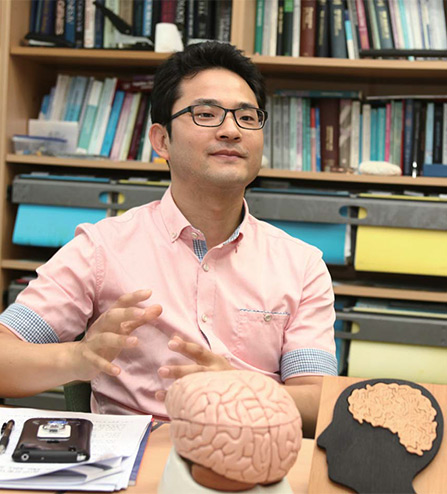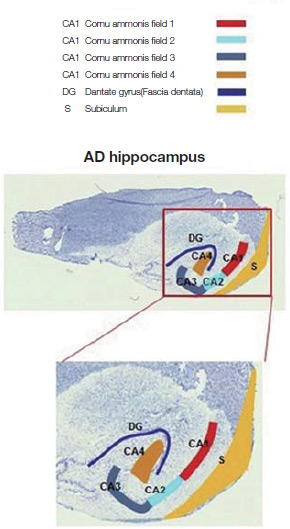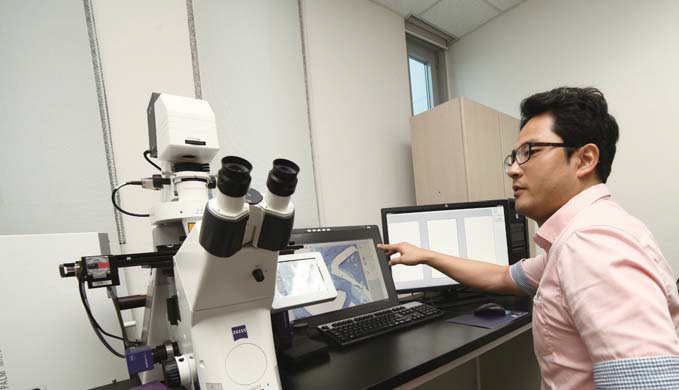Under the spotlight is a researcher who has identified proteins presumed to be a cause of Alzheimer’s disease (AD) by using a proteome analysis technology. It is Kim Jae-ho, a research fellow at the Center for Cognition and Sociality within IBS. He has been building a solid career in the field of research on the causes of AD. In an environment favorable to researchers at IBS, Dr. Kim continues his journey to complete the human brain proteome atlas.

Kim Jae-ho, Center for Cognition and Sociality
Inside the human head, there is a small universe, and that is the brain. The brain is often called the last frontier of modern science. The U.S.A. has launched the Brain Initiative to create a human brain proteome atlas, while the European Union has started Human Brain Project, actively promoting multilateral collaborative research. Promptly responding to this growing trend, Japan and China are also investing in studies on the brain. The entire world seems to have jumped into brain research in order to unlock the mysteries of the brain.
Three research centers in IBS are also striving to unveil the mysteries of the brain, and one of them is the Center for Cognition and Sociality, where Kim Jae-ho reads the properties of proteins and identifies the relations between them. He uses proteomics to enable the identification of protein types using mass spectrometry. To put it simply, proteomics is the large-scale study of proteins. It is to figure out networks between proteins and to understand the properties of specific proteins by analyzing proteome (a portmanteau of protein and ome, meaning “entire”), the entire set of proteins expressed by orders of genes, in a large scale.
Discovering proteins causing Alzheimer’s disease in the hippocampus in the brain

Hippocampal regions related to Alzheimer’s disease. Dr. Kim’s research focuses on CA4 and DG, which are poorly understood compared to other parts of the hippocampus. © Nature
“When it comes to brain studies, imaging technology like fMRI (Functional magnetic resonance imaging) is widely used, but proteomics has a distinctive strength. As it identifies types of proteins, it can acquire valuable information that is hard to find through imaging technology.
In other words, Proteomics allows in-depth analysis of proteins working in the brain. The only problem is that it is difficult to obtain specimens as they must be extracted from the brain.”
Dr. Kim is focusing on Alzheimer’s among many other brain diseases. He developed a strong desire to study basic science when he finished his undergraduate in Biotechnology and decided to go on to graduate school. He paid particular attention to the brain and concentrated on this field, and his effort was rewarded with a prize. In 2013, he won the excellent poster award at an international academic society for brain science.
“My Ph.D. advisor studied brain tumors in the Ajou School of Medicine. With his neurosurgery specialty, he treated patients and conducted research at the same time, so I had access to a wide range of clinical cases. And that is when I developed interest in Alzheimer’s disease. In 2007, I was sent to the Korea Basic Science Institute (KBSI), where I started to actively conduct research on proteomics. At first, proteomics was somewhat new to me but I believed that studying pproteins, a final pproduct of DNA, is significant in studying the brain"
Recently, Kim succeeded in discovering proteins causing Alzheimer’s disease. The hippocampus governing memory and learning plays important roles in the formation of higher intelligence. Many studies have proved the association between the hippocampus and AD. While most of the previous studies have dealt with CA1 and CA3 among main istological divisions of the hippocampus, Kim focused on CA4 and DG, which have not been explored much.
“As CA4 is a histological division only human hippocampus has, animal tests are impossible, and accordingly, a limited number of studies on CA4 have been carried out. However, I thought that to study diseases found only in the human, we would need to pay attention to CA4. My research team separated 5,000 types of proteins from CA4 and DG and identified 113 proteins expressed in patients with AD at least two times higher than ordinary people. Among the distinguished protiens, we verifed five proteins.
One of them causes depression and another is associated to oxidative stress reflecting an imbalance of biological oxidation due to increased production of oxidizing species.”
Kim also shared that this research almost could not be published. Last year when he attended a meeting of an academic society, he happened to see that a group of researchers from Germany were conducting similar research to his. Since, in the academic world, whoever first publishes is given priority, his team’s results were faced with obsolescence. It was an experience he never wants to have again. From this happening, he realized that researchers have similar thoughts and ideas.
Hoping to unravel relations among brain proteome, sociality, and genes
Brain study can be characterized by “giant science,” in which a variety of fields are integrated. Currently, many advanced countries are competitively launching a large-scale brain study project and they are making massive investments in it. The IBS also has established three research groups studying the brain. As the brain research requires active collaboration with other fields, the brain research groups are maintaining a close relationship with research teams at home and abroad. Kim and his research team have had a number of opportunities to carry out collaborative study with overseas research teams and attend meetings of international academic societies. In particular, Kim’s team has most frequently worked with French and Dutch research teams.
“European countries are funding a vast amount of subsidies to many research institutes as well as major pharmaceutical companies. When I was working in KBSI, we were funded a hundred thousand euro for a collaborative research project by Internationale Stichting Alzheimer Onderzoek (ISAO) in the Netherlands. It is different from the research environment here at home where a leading group has yet to appear in the brain study field. Considering that the robust specimen management system greatly contributes to active brain study in Europe, our country urgently needs to have well-established specimen management and distribution systems.”
Kim pointed out that the infrastructure related
to research on the brain is relatively weak compared to that of industrialized economies. Since researchers performing clinical work collect specimens little by little whenever they have the chance, it is hard to have a sufficient amount of specimens as needed for research. Thus, they now carry out research using specimens provided by Brazil and the Netherlands with strong infrastructure for brain study. He said that gradual development of domestic brain study infra systems would be helpful for distinguishing unique characteristics and factors of Koreans.
“Countries where an autopsy is mandated have robust brain specimen management system. They sort out specimens based on demographic information so as to be able to use them right to their research purpose, for example, ‘healthy women in their thirties’ or ‘men in their sixties with Alzheimer's disease' Detailed classification and thorough management of not only brain specimens but research specimens would allow us to identify in detail how characteristics of Koreans are associated with AD and whether there are certain factors reactive to brain diseases.”
Since Kim joined the Center for Cognition and Sociality in 2013, he has been following his goal of creating a human brain proteome atlas with detailed plans. He is devising joint research projects through convergence with new, various research fields other than proteomics.
One of the joint projects is executed within the Center for Cognition and Sociality, focusing on sociality, a main research subject of the research group. They are examining the association between social isolation, one of the symptoms of AD, and the hippocampus governing the sociality. It is highly likely that similar types of proteins work in developing common symptoms found in social impairments like autism.
In addition, gene analysis technology possessed by the group of researchers of RNA in IBS can be used for collaborative research. Recently, Kim’s review paper on proteogenomics dealing with integration of genes and proteins was published in journal BBA Proteins and Proteomics.

Dr. Kim is explaining ighresolution optical images obtained by laser capture microdissection (LCM).
The technique is a valuable tool since it allows researchers to make real-time observation of live cells.
Addressing brain disease mechanisms with Bioinformatics
“Many scholars and experts around the world talk about the next research subject after proteomics. That would be ‘connectomics.’ The concept is not only looking at functions of individual protein, but studying complicated interactions of proteins. In fact, it is often found that the functions of a protein completely charge according to whether a specific protein exists or not. If various brain disease research teams shared their research content and details, we could be able to achieve more. Of course, it should be supported by advanced bioinformatics that enables the collection and processing of a massive amount of data.”
Kim aims to develop a method of diagnosing Alzheimer’s disease by extending this research to find the causes of AD. He also said that he wants to apply bioinformatics to neurological disorders. That is because unexpected negative events often occur as different disease factors interact. Therefore, using bioinformatics will be of great help in acquiring as much information on proteins and genes as possible, based on which he hopes to discover mechanisms of brain diseases and neurological disorders.
Craving the study of human subjects, Kim started to study the brain – the most critical part of the human body. Lastly, he pointed out that "possibility" and "flexible thinking" are the most important virtues in studying brain science.
“When I was in France to participate in joint research, I was impressed by the French government’s strong support for research, although their facilities and equipment were out of date. Specifically, technicians were proud of what they were engaged in and their positive attitudes resulted in high research efficiency. In addition, their free discussion culture helped the researchers develop flexible thinking. IBS doesn’t bother researchers with pro forma research plans or complex administrative procedures. I think it is highly desirable to build an environment favorable to researchers, where we can concentrate on research. At IBS, I will continue to stick to the ongoing research in order to complete the human brain proteome atlas.”


 thumb.jpg
thumb.jpg














